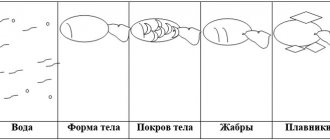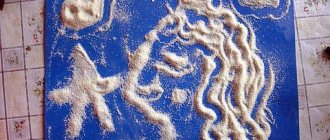Classification
According to fish taxonomy, the name of a superclass. They belong to the phylum chordates and include two classes - cartilaginous and bony fish. The first includes sharks and rays. They live mainly in the seas, some species are found in fresh water bodies. As their name suggests, their skeleton is made of cartilage. In addition, representatives of the class have the following features:
- the mouth is located on the underside of the head;
- asymmetrical caudal fin;
- absence of gill covers;
- absence of a swim bladder;
- placoid scales consisting of a plate and a spine directed backwards.
The bony fish class includes more than 90% of all fish species. They live in seas, fresh water bodies, rivers in different climatic conditions and have a predominantly bony skeleton. Their jaws are more developed and mobile, the mouth is located in front of the head, and the caudal fin is symmetrical. There is a swim bladder that allows you to adjust the depth of the dive. The gills are covered with gill covers.
TOP 1 article
who are reading along with this
Type Chordata - general characteristics
There are four subclasses of bony fish:
- cartilaginous - the skeleton consists of cartilage and bones;
- lungfish - gill and pulmonary respiration are present;
- lobe-finned - have a peculiar structure of fins that vaguely resemble limbs;
- Teleosts are the most numerous group.
Significant orders of bony fishes:
- sturgeon - sturgeon, sterlet, stellate sturgeon, beluga;
- herrings – Atlantic, Pacific herring, sprat, sprat, anchovies;
- salmon - salmon, trout, omul, pink salmon, chum salmon, grayling, salmon;
- carp - carp, roach, ram, bream, roach, crucian carp;
- perch - swordfish, tuna, gobies, river perch, pike perch, ruff.
Rice.
2. Representatives. It is believed that amphibians evolved from lobe-finned fish.
Structure of fish
Structure of fish
The organs of movement of all fish are fins. They are paired - pectoral and abdominal and unpaired - dorsal, anal and caudal. The body of the fish is protected by scales, which are bony plates that overlap each other like tiles. To reduce friction with water, the scales are covered with mucus.
The fish's two-chambered heart, consisting of an atrium and a ventricle, pumps blood through its vessels. The central nervous system is formed by the brain and spinal cord passing through a canal formed by the processes of the vertebrae.
Fish breathe with gills.
The lateral line as a sense organ is present in the majority of people. In a shark, it consists of the thinnest channels, lying almost half the skin on both sides of the body. Along the entire body of the shark stretch rays of nerve nodes - ganglia, from which structures resembling hairs enter into the canal cavity filled with liquid.
Fish superclass
- Integument, musculoskeletal system
- Digestive system
- Respiratory system
- Circulatory system
- Excretory system
- Nervous system
- Reproductive system
The body shape is streamlined, fish-shaped, thereby reducing friction with the water. The surface of the body is covered with overlapping scales (like tiles).
In most species, the scales are ctenoid (from the Greek ktéis - ridge and éidos - view) - equipped with teeth or spines, or cycloid (from the Greek kykloeides - circular, round) - with a smooth rounded rear edge.
The skin contains many glands that secrete mucus that covers the entire body of the fish, thereby reducing friction with the water. Because of the mucus, it is difficult to hold the caught fish in your hands; it slips out.
Fins are the organs of movement of fish. Fins can be either paired (pectoral, ventral) or unpaired (dorsal, caudal, anal).
The skull is the seat of the brain and surrounds it on all sides. Characteristic is the presence of a rostrum (from Latin rostrum - beak) - the front elongated part of the fish skull.
The spine consists of two sections: trunk and caudal. There is a hole in the center of each vertebra. Adjacent to each other, the openings of the vertebrae are connected together into a single spinal canal, in which the spinal cord lies.
The skeleton of the pectoral fins is connected to the spine by the bones of the pectoral girdle, in contrast to the skeleton of the pelvic fins, which is not articulated with the spine. There are gill covers that cover the gill slits from the outside (in cartilaginous fish there were no gill covers; 5 gill slits each opened separately to the outside.)
The body cavity is secondary (coelom).
The muscular system is segmented, which is expressed in the appearance of separate (differentiated) muscle bundles. The most striking example of differentiation is the muscles of the oral apparatus and paired fins.
Consists of the oral cavity, pharynx, which continues into the esophagus, stomach, large and small intestines. Many fish have a tongue and sharp teeth located on the jaws in their mouths. Teeth are not designed for mechanical grinding of food, but mainly for grasping and holding prey. There are no salivary glands, but there are taste buds.
The ducts of the digestive glands, liver and pancreas, as well as the gall bladder open into the lumen of the small intestine of fish. There is no spiral valve in the intestine (characteristic of cartilaginous fish), the total absorption area is increased due to blindly ending intestinal outgrowths - pyloric appendages.
The pharynx is closely connected not only with the digestive system, but also with the respiratory system: the gill apparatus of fish is located here. With the help of gills, they have adapted to take oxygen dissolved in it from the water and saturate the blood with it, from where oxygen is supplied to the internal organs and tissues.
The breathing process is carried out due to the fact that water enters the pharynx through the mouth. Due to the movements of the operculum, water from the oropharyngeal cavity is drawn into the lateral gill cavity, washing the gills. As a result of gas exchange, oxygen enters the blood of the fish, and carbon dioxide leaves it and dissolves in the water.
The gills consist of a gill arch on which the gill rakers and petals are located. The gill rakers are directed towards the oropharyngeal cavity and prevent the penetration of food particles into the gills (filtration function). The gill filaments are directed outward and are intertwined with a dense network of blood vessels - capillaries, in which gas exchange occurs.
Like cartilaginous fish, bony fish have one circulation. The heart is two-chambered, consisting of one atrium and one ventricle. Remember that fish have venous blood in their hearts. It is pumped by the heart into the gills, where it is saturated with oxygen, after which the blood becomes arterial.
Arterial blood is directed to internal organs and tissues, blood moves inside the vessels: a closed circulatory system.
It consists of paired ribbon-shaped trunk kidneys (mesonephros, or primary kidney.) They are located on the sides of the body. The ureters begin from the kidneys, merging with each other and forming an extension - the bladder.
Urine containing metabolic by-products is excreted from the fish’s body through the anus in females and through the genitourinary opening in males.
All chordates have a tubular nervous system. The brain consists of the medulla oblongata, midbrain, cerebellum, diencephalon and forebrain.
The development of the same sections in different classes of chordates is not the same, which we will clearly see as we study this section. I recommend that you pay special attention to this topic.
Compared to other classes of chordates, the brain of fish is poorly developed: the forebrain cortex is absent, instead the surface of the brain is covered with epithelium. The midbrain, the main coordinating center, reaches its greatest development.
The cerebellum, which is responsible for coordination of movements and orientation of the body in space, is also well expressed (developed). This is due to the complex movements of the fish, which “soars like a bird” only not in the air, but in the aquatic environment. 10 pairs of cranial nerves originate from the brain.
The sensory organs of a fish are represented by a special formation - a lateral line, stretching in the form of a channel along the entire body on both sides. Sensitive cells (neuromasts) of the lateral line organ respond to changes in the direction and speed of water flow near the fish. With its help, the fish senses the direction and speed of the water flow.
In fish, a specialized hearing organ—the inner ear—appears for the first time. With its help, they are able to distinguish sounds while navigating in the aquatic environment. The inner ear consists of three semicircular canals, the upper and lower saccules. Sometimes the inner ear is connected to the swim bladder (catfish, carp), due to which the hearing in such fish is more developed.
The organs of vision are adapted to the aquatic environment: the lens has a spherical shape. The cornea is flat, accommodation (adjusting the eye to the best vision of an object) occurs only due to the movement of the lens.
Fish see well only at close range. There are taste organs on the skin and lower jaw, as well as olfactory organs that open into the oral cavity.
Fish are dioecious. The gonads of males are testes, of females - a single ovary. Fertilization is external and occurs in water: the female lays eggs (eggs), and the male releases sperm into the water, which merge with the eggs. Over time, young individuals develop from eggs.
Development in most fish (teleosts) is indirect, with metamorphosis. Remember that the process of laying eggs and their subsequent fertilization is called spawning, it is seasonal. Freshwater fish spawn in the spring; fishing is strictly prohibited at this time.
Summary of a lesson in the senior group on the topic “Who are fish?”
Summary of a lesson in the senior group on the topic “Who are fish?”
Target:
to form children's ideas about fish: structure, method of reproduction, nutrition.
Tasks:
Educational:
Learn to identify the characteristic features of various fish; classify fish (marine, freshwater, aquarium).
Developmental:
Develop the ability to observe, analyze, draw conclusions, and enhance children’s speech activity.
Educational:
To cultivate a caring attitude towards nature, to develop a sense of beauty and harmony in nature.
Materials:
Magnetic poster “Reservoirs”, illustrations depicting marine and freshwater fish, chips, a sheet of paper (divided into 2 stripes), blue and green circles, cut-out pictures.
Vocabulary work:
Clarify the concepts: scales, gills, marine and freshwater fish; introduce a general concept - “fish”, “reservoirs”.
Preliminary work:
Reading the works of A. Klykov “Under water in winter”, L. Karpov “How do fish winter?”, A. Pushkin “The Tale of the Fisherman and the Fish”, learning proverbs: “That’s why the pike is in the river, so that the crucian carp does not sleep”, “ The frost is angrier, but the burbot is more lively”; outdoor games: “Fishing Rod”, “Crucian Carp and Pike”.
- Guys, today we will go on a water trip. What will you and I sail on?
Children's answers: steamship, ship, boat.
— That’s right, now you and I are going on a trip on a motor boat.
- Get ready, take the steering wheel in your hands, start the engine (Children pronounce the sound “rrrr...”). Carefully! Turn - right, then - left, again - right, once again - left, now we are heading straight; turn off the engine... (children pronounce the sound "rrrr..." quieter and quieter).
- And now we find ourselves on a pond (the teacher shows a magnetic poster “Reservoirs”).
— Guys, what kind of reservoir do you think this is?
Children's answers: river, pond, lake.
- Indeed, guys, we found ourselves on a freshwater body of water (river or lake). Look how diverse and beautiful the flora and fauna on the pond are!
- Please note that it is as if the reservoir is divided into two parts: one part is the surface and coastal ones, almost indistinguishable, the other is the underwater world.
- Tell me the inhabitants of the surface world that you see in the picture.
Children's answers: insects (water striders, butterflies and dragonflies, etc.), frogs, herons, beavers, water lilies, lilies, etc.
- Tell me the inhabitants of the underwater world that you observe.
Children's answers: snails, crayfish, river fish, swimming beetle, algae, etc.
- Now let's play. Game “Who Lives Where?”
We play in teams (the 1st team needs to select pictures depicting the inhabitants of the flora and fauna of the above-water part. The 2nd team needs to select pictures depicting the underwater world). For the correct answer, the team is awarded 1 point (chip). At the end of the lesson, points are calculated. The one who completes this task faster and more correctly wins.







